M.S.Arseneva senior tutor d \\ s 21 "Fairy tale" The leading goals of the kindergarten's interaction with the family are to create in kindergarten the necessary conditions for the development of responsible and interdependent relationships with the families of pupils, ensuring the holistic development of the preschooler’s personality, and raising the parents ’competence in the field of education.
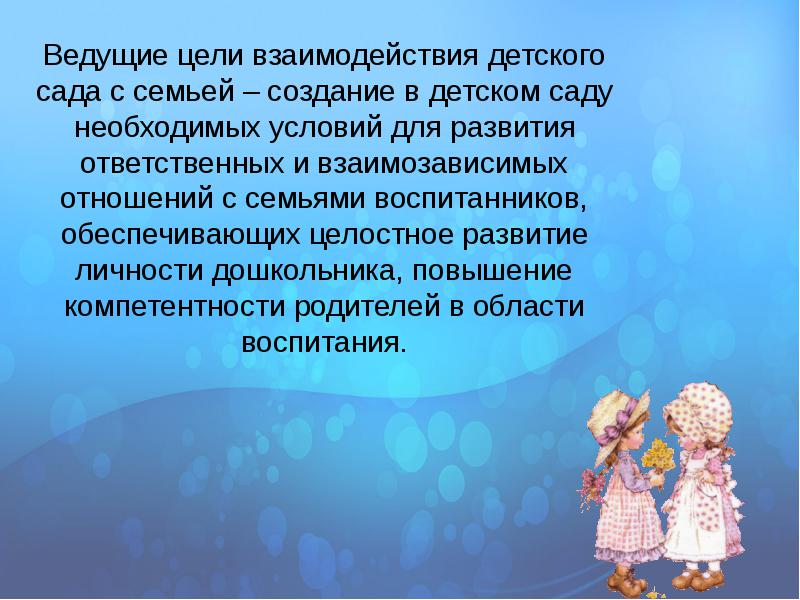
The main forms of interaction with the family

The main forms of interaction with the family
Familiarity with the family:meetings - dating, visiting families, questioning families.
Informing parents about the educational process:open days, individual and group counseling, parents' meetings, decorating information stands, organizing children's art exhibitions, inviting parents for children's concerts and holidays, creating reminders, Internet magazines, email correspondence.
Parent Education:organization of “parent / father school”, “school for parents” (lectures, seminars, workshops), master classes, trainings, creation of a library (media library).
Team work:involvement of parents in organizing music and poetry evenings, living rooms, contests, concerts of the family Sunday subscription, weekend routes (to the theater, museum, library, etc.), family associations (club, studio, section), family holidays, walks, excursions, family theater, to participate in children's research and project activities. 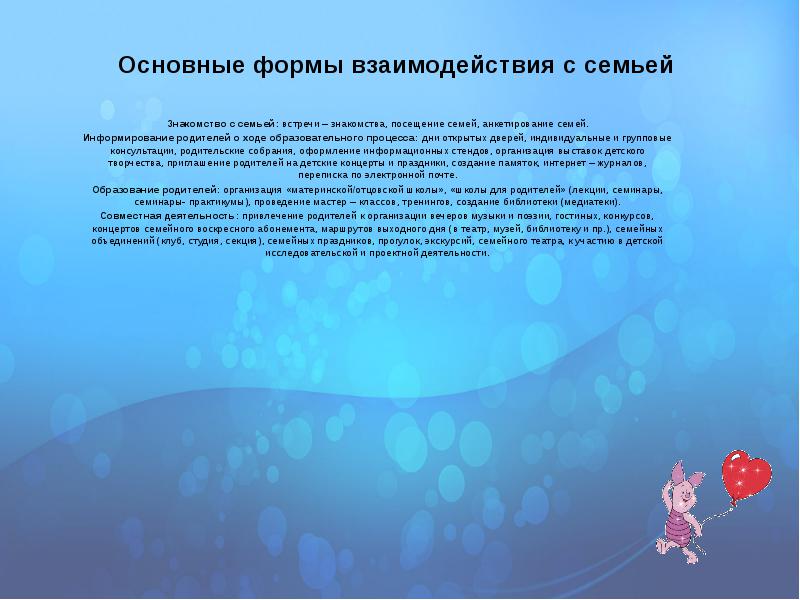
Health education area
Educational field "Physical Education"
Educational area "Security"
Educational area "Socialization"
Educational field "Artistic creativity"
Educational area "Music"
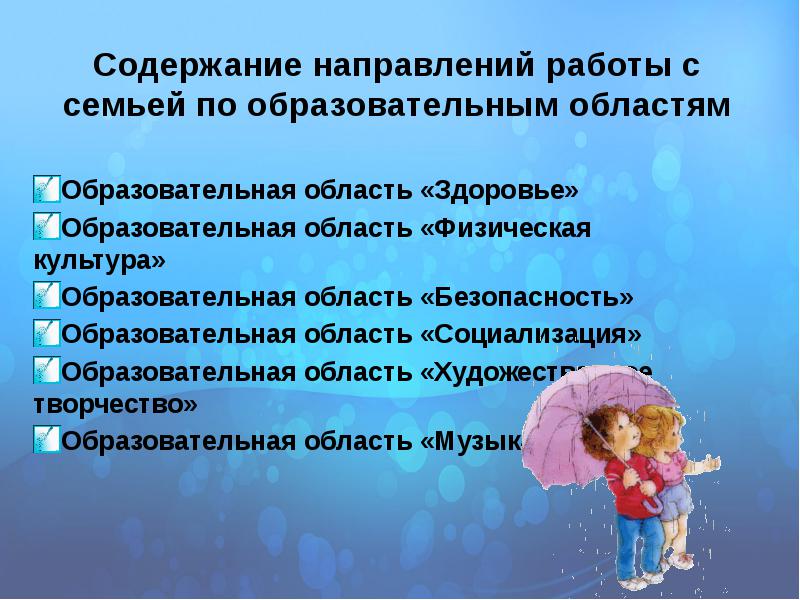
The main approaches to the definition and implementation of the role of parents as subjects of preschool education
The democratization processes in the education system, its variability, innovative programs have necessitated the search for solutions to the problems of interaction between the preschool educational institution and the family, creating conditions for raising the pedagogical culture of the parents.
Practitioners and researchers have identified and formulated the following contradictions in this regard:
between the need of parents for educational services and the lack of conditions for their provision;
between the desire of parents to be active in a preschool institution and the strictly regulating nature of the institution’s activities;
between the low level of pedagogical culture and insufficient knowledge of the fundamentals of psychology by parents and the lack of their education systems in preschool institutions.
between the rights and duties of parents and the inability to use them;
Strengthen and develop close ties and interactions of various social
institutions (kindergarten, family, community) provide favorable conditions for the life and upbringing of the child, the formation of the foundations of a full-fledged, harmonious personality. 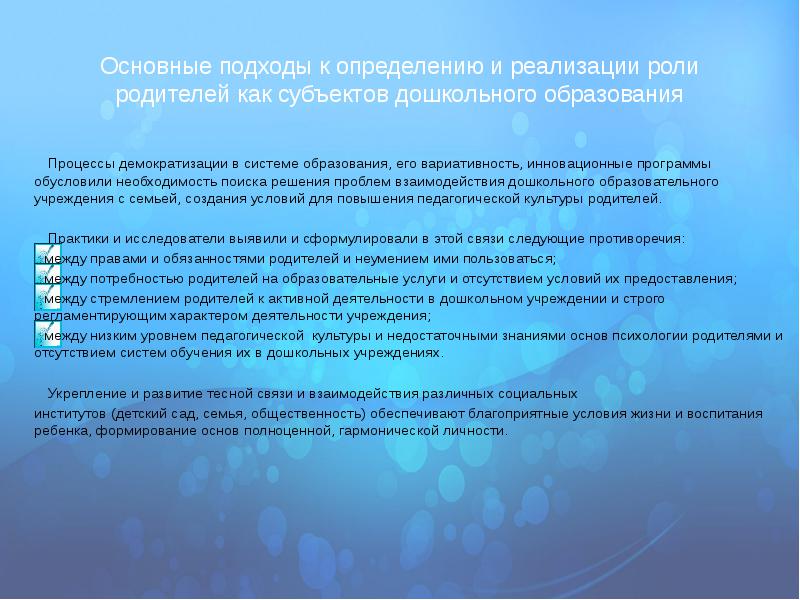
At the present stage, the basis of the joint activities of the family and preschool institutions is based on the following principles:
parents and teachers are partners in the upbringing and education of children;
this is a common understanding by teachers and parents of the goals and objectives of the upbringing and education of children;
help, respect and trust in the child, both from teachers and from parents;
knowledge by teachers and parents of the educational capabilities of the collective and family, the maximum use of the educational potential in teamwork with children;
continuous analysis of the process of interaction between the family and the preschool institution, its intermediate and final results.
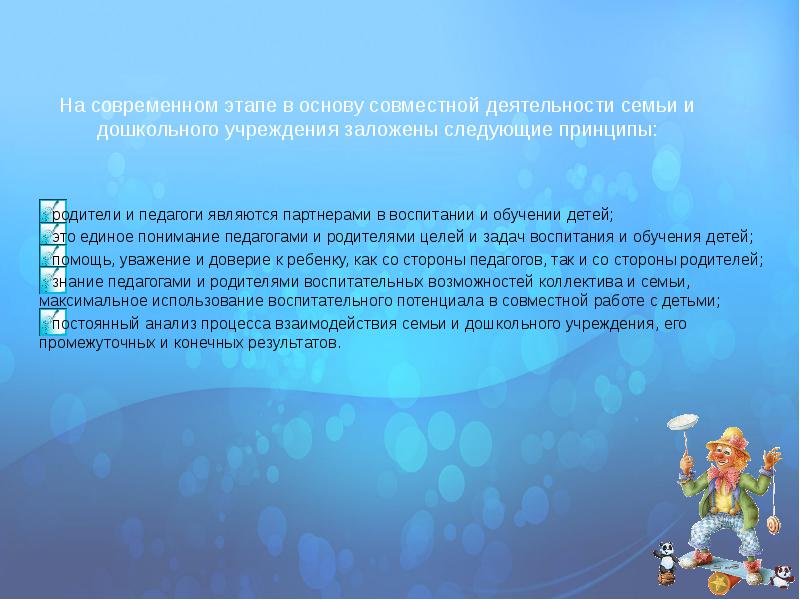
The idea of the interrelation of social and family education, as well as the mutual responsibility of teachers, parents and the public, is reflected in a number of regulatory and legal documents, including "Concepts of pre-school education", "Regulations on pre-school educational institution", the Law "On Education" and others.
Thus, the Law “On Education” states that parents are the first teachers. They are obliged to lay the foundation for the physical, moral and intellectual development of the child’s personality at an early age.
In accordance with this, the position of the preschool institution in working with the family also changes. Each preschool not only brings up the child, but also advises parents on the issues of parenting. In this regard, the pre-school educational institution should determine the conditions of work with parents, improve the content, forms and methods of cooperation between pre-school and family in raising children, taking into account changing conditions, variable educational programs and the needs of families. The teacher of a preschool institution is not only an educator of children, but also a partner of parents in their upbringing.
The pedagogical culture of parents is understood to be their sufficient preparation, the development of those personality traits that reflect the degree of their maturity as educators and manifest themselves in the process of family and social upbringing of children. The leading component of the pedagogical culture of parents is their pedagogical preparedness, which is characterized by a certain amount of psychological, pedagogical, physiological, hygienic and legal knowledge, as well as the skills and abilities of parents developed in the process of parenting children. 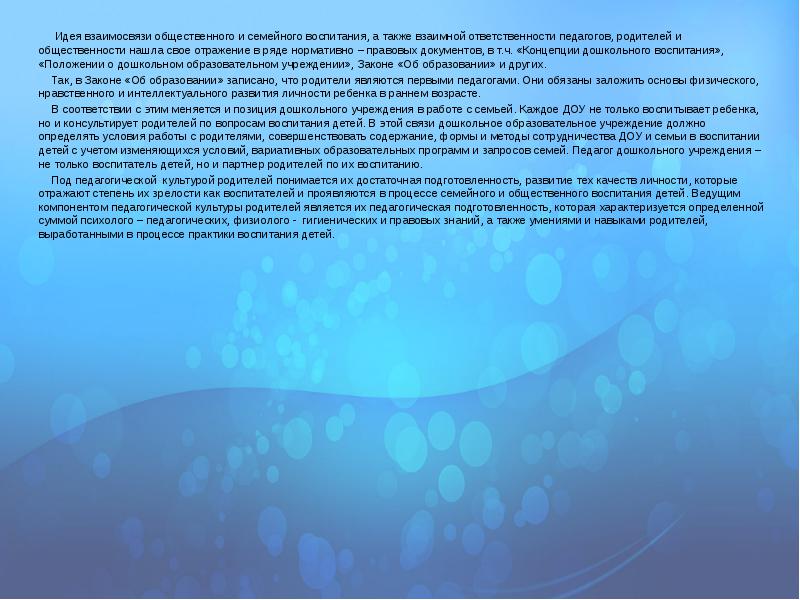
In the field of preschool pedagogy, parents need:
know the basic laws and features of the upbringing and education of children;
get acquainted with the content and methods of education;
master the methods of organizing children's activities, communication, aimed at the formation of socially valuable forms of behavior and the child’s relations with people around them.
Pedagogical culture is considered in connection with the general social and pedagogical conditions of upbringing, which include the totality of the main requirements of society to the personality of parents, the content of ideological and moral norms governing intrafamily relations, the nature of interpersonal relations in the family.
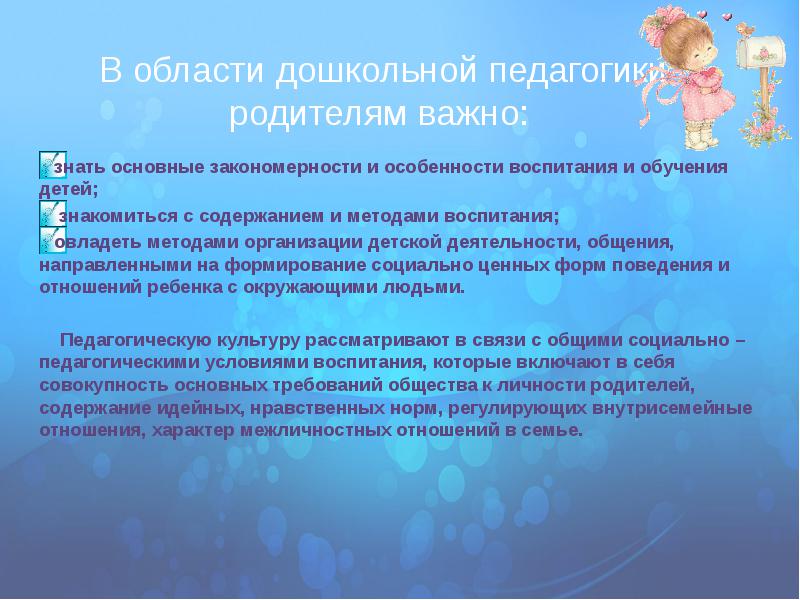
In accordance with this, work with parents is based on the principles of cooperation. Signs of such cooperation are:
awareness of the goals of each participant in the process;
a clear division and cooperation of labor between its members;
personal contact between participants in the process with the exchange of information, mutual assistance, self-control;
positive interpersonal relationships.
children; interaction of educators and parents in the development of children.
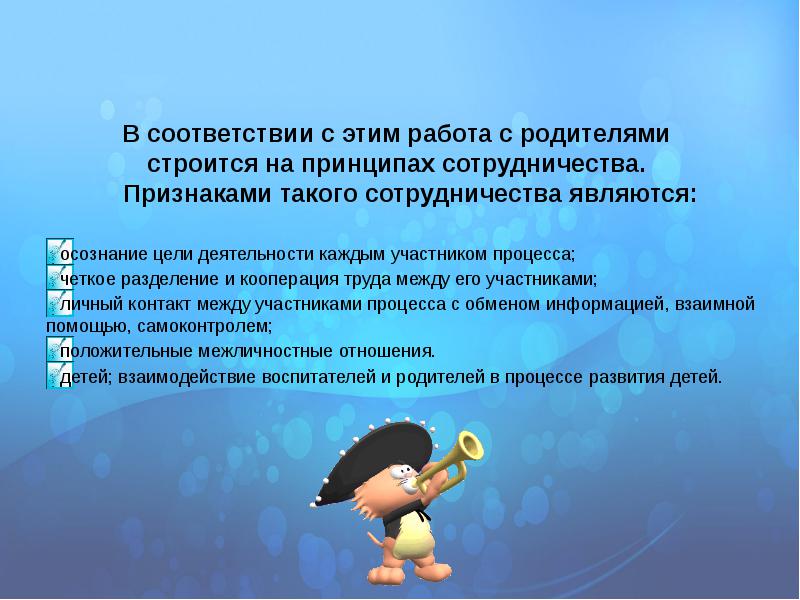
We can highlight the main tasks facing the preschool institution in working with parents:
studying families of children;
attracting parents to actively participate in the activities of the preschool institution;
study of family experience in the upbringing and education of children;
parent education in pedagogy and child psychology.
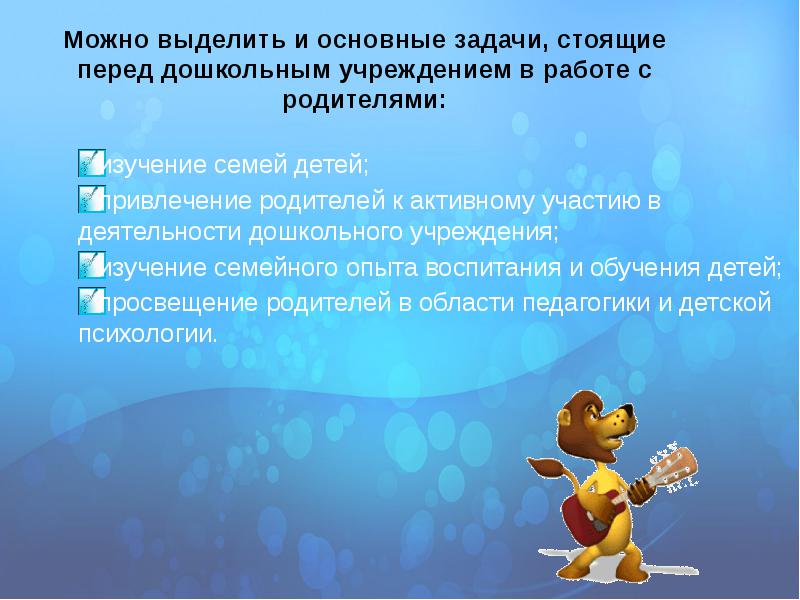
The content, organization and methodology of cooperation between preschool and parents includes:
unity in the work of the kindergarten and the family in raising children;
mutual trust in the relationship between teachers and parents, understanding the needs and interests of the child and their responsibilities as educators; strengthening the authority of the teacher in the family and parents in kindergarten;
establishing the right relationship based on benevolent criticism and self-criticism;
mutual assistance in working together to educate preschoolers. Kindergarten helps parents every day in raising their children. In turn, parents help the kindergarten in a diverse educational and economic work;
studying the best experience of family education, promoting it among a wide range of parents, using positive methods of family education in the work of the kindergarten;
the use of various forms of kindergarten work with the family in their relationship: familiarization with parents and other family members; consultations; group and general parent meetings; conferences, lectures, parent universities, visual forms of propaganda;
individual and group forms of work with parents, which complement each other. The daily communication of the caregiver with the parents creates great opportunities for individual work, for strengthening the connection between the family and the kindergarten;
systematic planned communication of the kindergarten with parents throughout the year, taking into account the objectives and content of educational work with children;
attraction of parents' assets, the public to the activities of the preschool institution, to work with families.
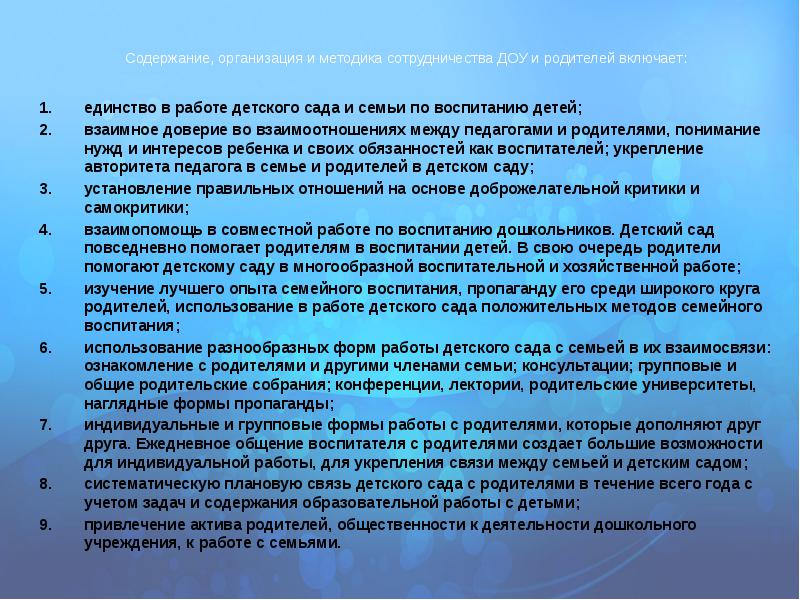
Spectrum of actions for the involvement of parents in the activities of DOE.
1. First contacts between families and pre-school inviting parents with or without children to visit the institution before the start of the lesson;
family visits at home;
providing parents with written information about the institution;
a meeting to clarify the conditions for the child to attend the institution;
preparation of contract.
2. The further relationship of parents and staff is implemented in the process: daily direct contact when parents bring and pick up children;
informal conversations about children or scheduled meetings with parents to discuss successes, regardless of specific problems;
familiarizing parents with written material about their children;
visits to parents so that they can see how their child is involved, or get acquainted with the work of the institution.
3. Parents are invited to assist the kindergarten as organizers or sponsors; they can help in developing the contents of a game store, collecting materials for children's needs, etc.
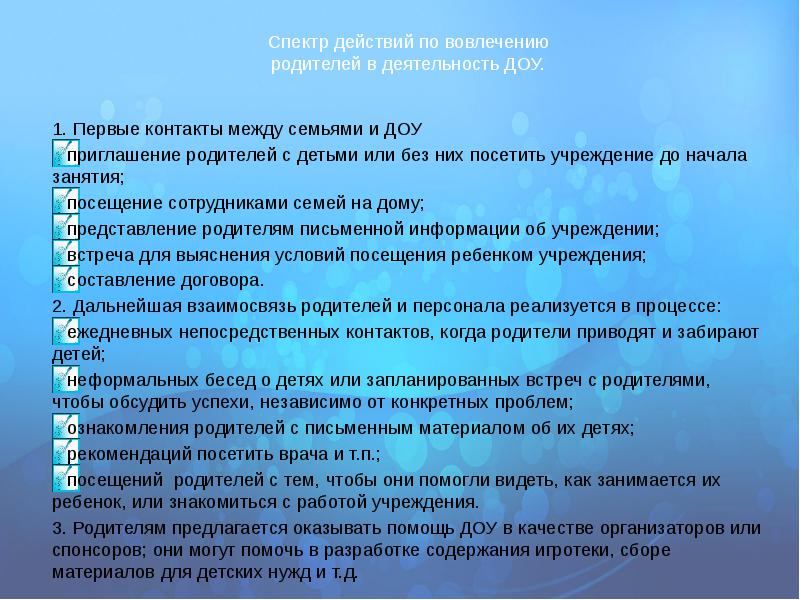
(continued)
inviting parents with or without children to visit the institution before the start of the lesson;
family visits at home;
providing parents with written information about the institution;
a meeting to clarify the conditions for the child to attend the institution;
preparation of contract.
daily direct contact when parents bring and pick up children;
informal conversations about children or scheduled meetings with parents to discuss successes, regardless of specific problems;
familiarizing parents with written material about their children;
visits to parents so that they can see how their child is involved, or get acquainted with the work of the institution.
3. Parents are invited to assist the kindergarten as organizers or sponsors; they can help in developing the contents of a game store, collecting materials for children's needs, etc.

(continued)
4. Parents can participate in the daily activities of children: stay in preschool, so that the child is accustomed to the institution; to help and participate in various activities, such as tea drinking with children, etc .; help with daily activities; assist with guided tours and other events.
5. Parents continue to work at home with children on programs or implement part of a home plan.
6. Parents can participate in making decisions about their children; parent committees are involved in issues related to the work of the institution as a whole.
7. Effective social activities for parents; they attend courses on parenting issues or invite lecturers on issues of interest to them, the work of a club for parents, etc.
8. DOW provides assistance to parents in the specific problems of child care, methods of education; in the accumulation of information on family education and practical advice; in search of a way out of crisis situations. 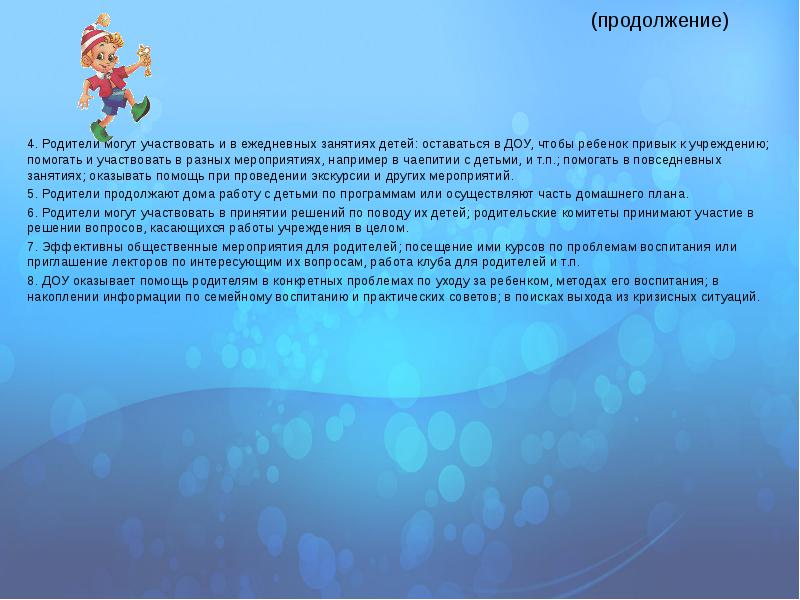
Organization of cooperation of teachers, parents and children
The formation of cooperation of children, parents and teachers depends primarily on how the interaction of adults in this process. The result of education can be successful only if teachers and parents become equal partners, since they bring up the same children. The basis of this union should be the unity of aspirations, views on the educational process, jointly developed common goals and educational objectives, as well as ways to achieve the intended results.
Both teachers and parents want to see their children healthy and happy. Parents are ready to support the initiatives of teachers aimed at meeting and developing the interests and needs of their children. Parents are adults who have a lot of life experience, knowledge and can analyze situations, so the teacher can get their necessary and useful advice in solving a number of problems. 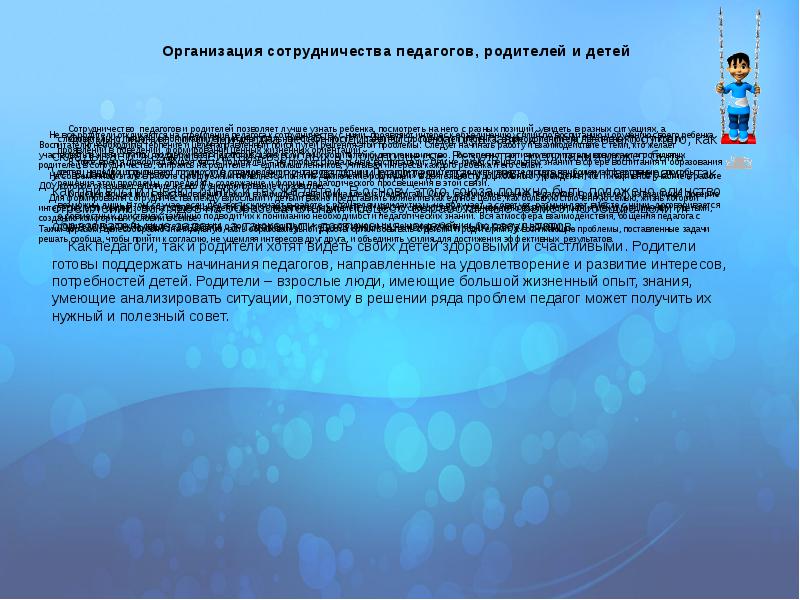
To attract parents to the activities of preschool institutions, a special methodology has been developed, which includes three stages:
the first is the actualization of the needs of parents in the education of their own child;
the second is the pedagogical education of parents as customers for educational services in preschool institutions;
the third is a partnership of teachers and parents in the activities of a preschool institution, which is based on the ideas of humanizing relationships, the priority of human values with an emphasis on the personality-activity approach.
The introduction of such a technique allows you to create a sophisticated system of working with parents, represented by two blocks, each of which includes tasks, forms and activities.
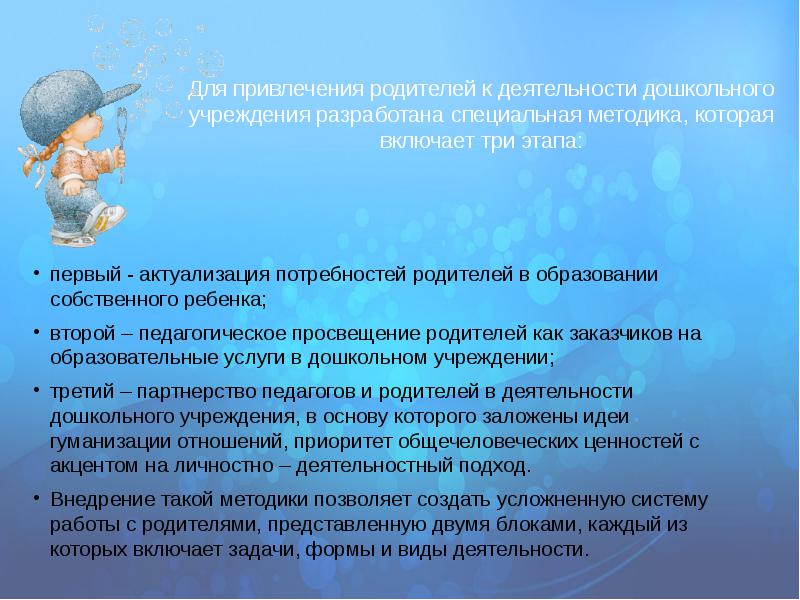
The main units for working with parents
the first is the actualization of the needs of parents in the education of their own child;
the second is the pedagogical education of parents as customers for educational services in preschool institutions;
the third is a partnership of teachers and parents in the activities of a preschool institution, which is based on the ideas of humanizing relationships, the priority of human values with an emphasis on the personality-activity approach.
The introduction of such a technique allows you to create a sophisticated system of working with parents, represented by two blocks, each of which includes tasks, forms and activities.
The analysis of the practice of work of teachers and preschool educational institutions revealed 2 types of forms of collaboration: 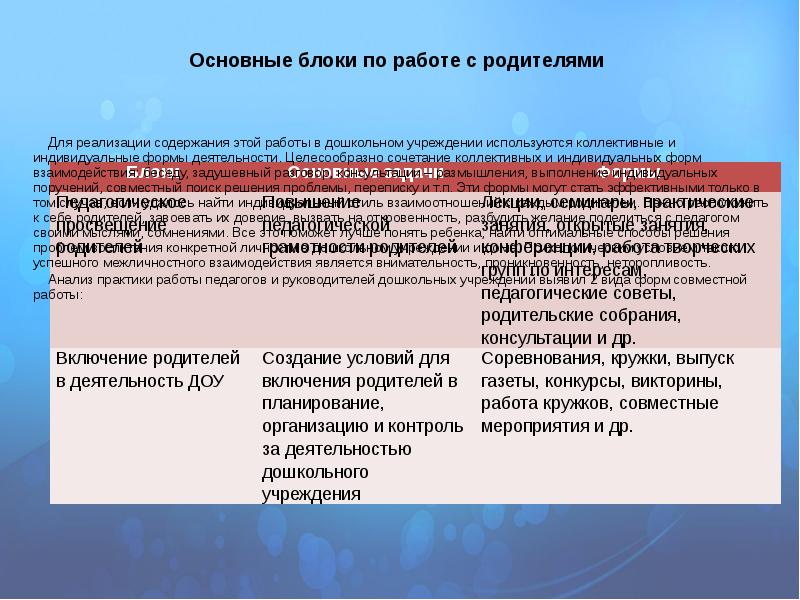
Joint activities of teachers and parents
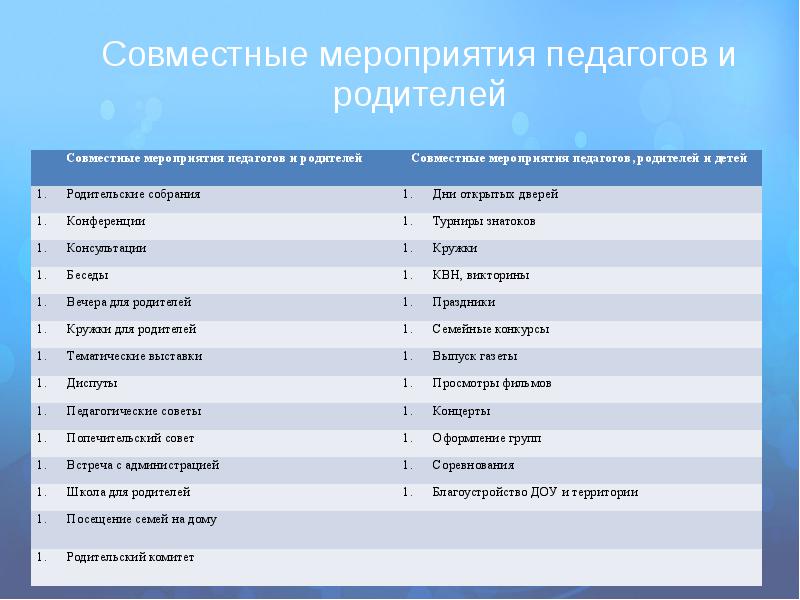
Analysis theory and practice of working with the family revealed another problem at the present stage - the organization of joint activities of parents and children. One of the main tasks of teachers is to create conditions for the development of normal relations in the family, and this can be achieved only through the activities of parents and children, which can be implemented in various forms.
For example, forms cognitive activity - these are public reviews of knowledge and skills, creative reports on areas of activity, holidays of knowledge and creativity, tournaments of experts, Open Days, etc. Parents and caregivers determine the subject, topic, methodology of conducting together. The teacher makes up tasks, helps to form groups, organize preparatory work, and parents participate in the design, preparation of incentive prizes, and evaluation of results. 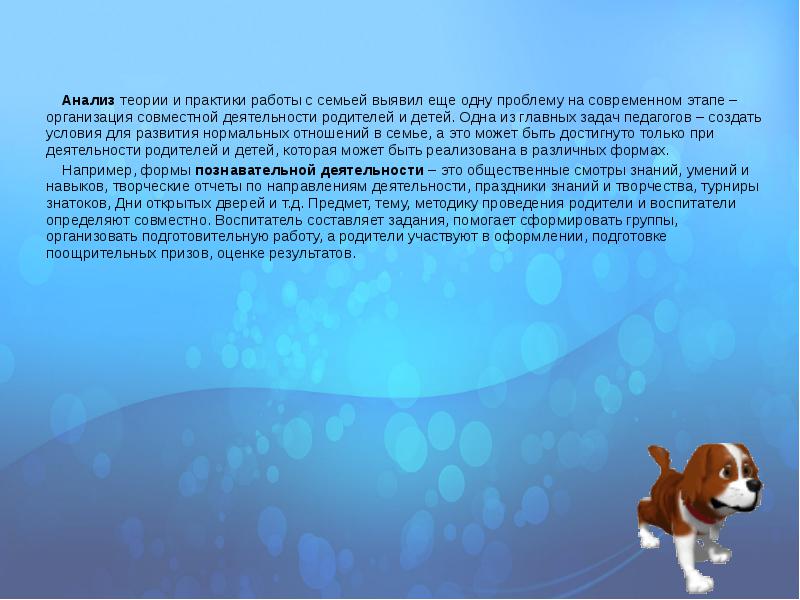
Forms labor activity -
Forms labor activity -the design of the group’s premises, the labor force for landscaping and gardening the yard, planting the avenue in connection with a significant event in the lives of children and their parents, creating a library, etc.
Forms leisure time- preparation, conduct and discussion of performances, holidays, competitions, contests, KVN; various clubs, etc.
Forms activation -discussions, dialogues, discussion of situations, crossword puzzle solutions, analysis of children's utterances or children's creativity, trainings, game simulation method, etc.
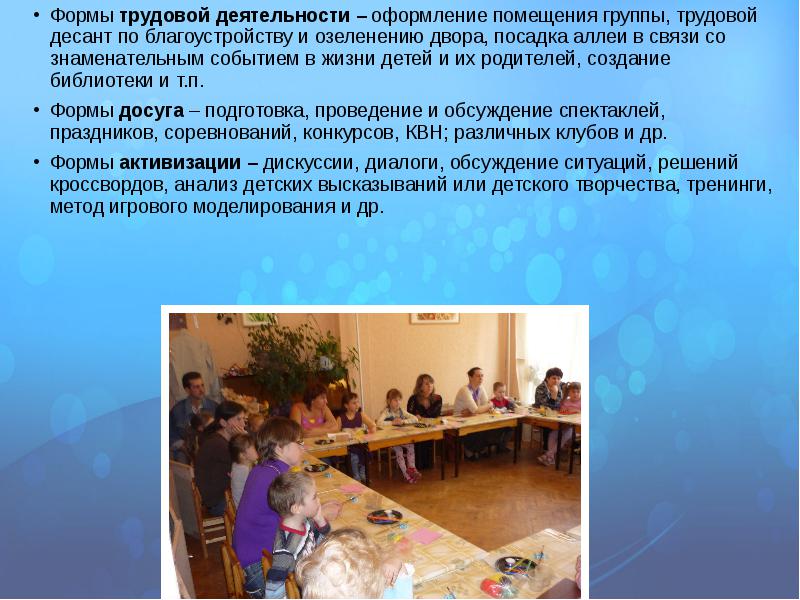
Visual forms:
Visual forms:libraries and folders - advances, videos, memos - recommendations for parents and children, postcards - invitations, business cards, exhibitions of books, equipment, board games, children's or joint drawings, crafts with parents, photo exhibitions, newspapers, Corners for parents, etc.
Of the relatively new forms of work with parents, it should be noted videos that are created on a specific topic, for example, “Labor education of the child in the family”, “Labor education of children in the kindergarten”, etc.
An interesting form of cooperation is the publication of the newspaper. The creation of the newspaper involved the administration of the kindergarten, teachers, professionals, parents and children.
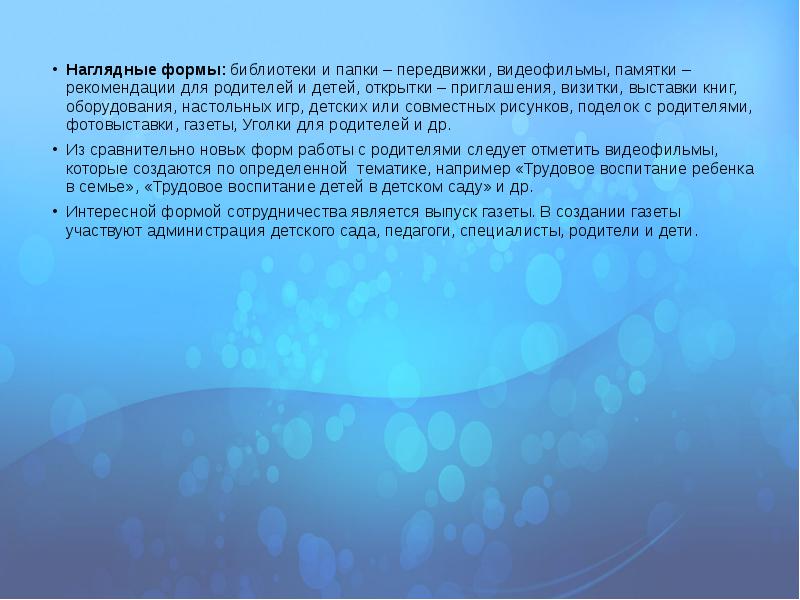
In theory and practice, a number of common tasks for working with parents in preschool institutions are defined:
studying the interests, opinions and requests of parents who are not implemented in other social institutions (family, etc.);
providing optimal conditions for self-development and self-realization of parents in their assimilation of various social roles;
using the experience of other preschool institutions to build a model of interaction with parents;
expanding tools and ways of working with parents;
providing space for personal growth of participants of the association, creating a special creative atmosphere.
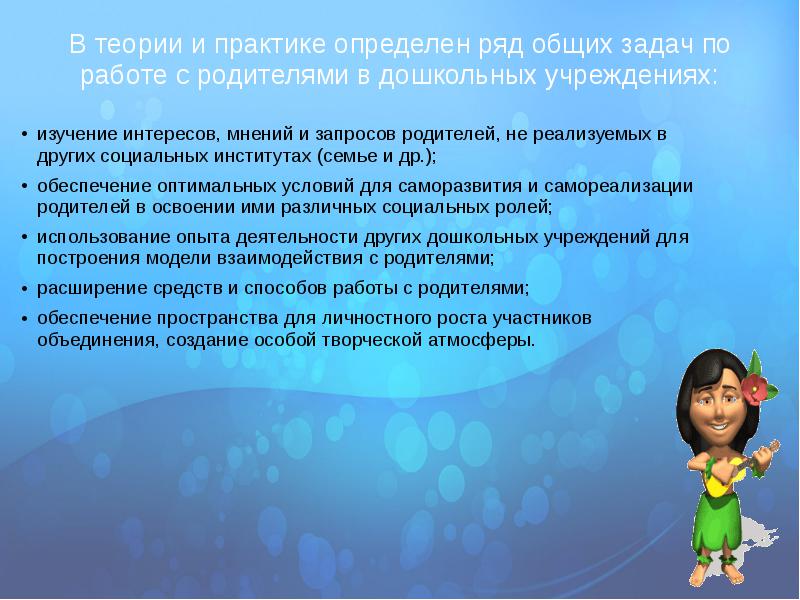
On the topic: "Our kindergarten, glad to see you!"
Astapova Elena Alexandrovna
The tutor MBDOU d \\ with №49
P.Druzhny
Kstovo
2014
Preliminary work:
Plan:
1. Greeting (introduction)
2. A game for dating.
3. Results of adaptation
4. Introduction to the program
1. Greetings.
Here we are!
2. A game for dating.
- love to sleep;
- love sweet.
- love to work in the country;
- love to spend money;
- love to travel.
3. Adaptation in kindergarten.
4. Acquaintance with the program.
ANNEX 1
Results of adaptation.
Tips for parents
Tips for parents
Tips for parents
Tips for parents
Tips for parents
Tips for parents
APPENDIX 2
APPENDIX 3
how not to behave
how to love your baby
rule one:
rule two:
third rule:
fourth rule:
rule five:
APPENDIX 4
Memo for parents
General recommendations:
- Replaceable comfortable shoes
- Socks, socks
- T-shirt for sleeping
- Clean handkerchiefs
Methodical development of the parent meeting in the second junior group of kindergarten
On the topic: "Our kindergarten, glad to see you!"
Astapova Elena Alexandrovna
The tutor MBDOU d \\ with №49
P.Druzhny
Kstovo
2014
Parent meeting in the second junior group
Theme: "Our kindergarten, glad to see you"!
Preliminary work:
Arrange the chairs in a semicircle, prepare places for parents.
Make a reminder for parents "For the first time in kindergarten."
To issue the wall newspaper "Our Kids".
Purpose: The main purpose of our parents' meeting is the mutual communication of teachers and parents, the exchange of necessary information for the successful stay of the child in kindergarten. Modeling prospects and challenges in the school year.
Plan:
1. Greeting (introduction)
2. A game for dating.
3. Results of adaptation
4. Introduction to the program
5. Selection of the parent committee.
1. Greetings.
Tutor 1. Good evening. We are glad to see you at our first meeting. Today we have with you the first parent meeting, where we will meet, get to know each other better. We will tell you about what the children learned during the period of adaptation to kindergarten and what they still have to learn.
After that, we will select a parent committee with you and discuss current issues.
Here we are!
The teachers show their parents a wall newspaper with photos of the group’s students and offer to talk briefly about their family, the character and habits of the child, family traditions.
Teacher 2. So, you brought your children to kindergarten and we have one common goal: to make their stay here comfortable, safe, interesting, exciting, informative, etc.
During the child’s stay in kindergarten, we (children, teachers, parents) form a triangle. At the head of the triangle, of course, is a child. What do you think will happen to a tripod stool if one leg breaks? (falls) That's it, falls! Remember Krylov's fable "The Swan, Cancer and Pike," which says: "When there is no agreement in the comrades, their business will not work, it will not work for him, only flour!" Consequently, we need to join forces in order for children to be interested and comfortable in kindergarten, and here it is very important to have mutual understanding and support. We will live with you for 4 years alone, I hope, a close-knit family. And first you need to take a closer look.
2. A game for dating.
Educator 1. Parents pass the ball, who has the ball in their hands, he says, what is his name, what is the name of the child, how old is the child and how long have he been walking in the garden.
Educator 2. Exercise "My mood."
Everyone comes to kindergarten with a different mood. To find out the mood of the children, we play such a game, the children show and speak in a circle: palm squeezing is tense, hands wide apart are wonderful, hands on their knees are calm. Let's try to appreciate the atmosphere of our meeting. Show with gestures the mood with which you came to our meeting.
Educator 2. Exercise "My habits."
All people are different, but there is something that unites them and makes them interesting to each other - these are habits and interests. Parents are invited to perform tasks that, in their opinion, reflect their own habits and interests:
Go out to the circle and shake hands with those parents who:
- love to sleep;
- love sweet.
Go out in a circle and jump on one leg, those who:
- love to work in the country;
- love to make jam, to make preparations for the winter.
Go out in a circle and dance those parents who:
- love to spend money;
- love to travel.
Educator 2. Exercise “Adaptation is good or bad.
Parents pass the ball and continue the phrase: “Adaptation is good, because ... (parents opinion)” and pass on to the next; he should continue “Adaptation is bad because ...”
In our group there is a shelf of creativity of parents, where we exhibit crafts of our parents. We hope that by the next meeting we will have a lot of your work, and we will be able to organize the whole exhibition.
3. Adaptation in kindergarten.
The teacher makes a report on this problem. (see APPENDIX 1)
4. Acquaintance with the program.
The teacher introduces parents to the educational program. (see APPENDIX 2)
5. Tell about the age features of children 3-4 years.
Give advice on parenting. (see APPENDIX 3)
6. Selection of the parent committee.
Educators explain to parents the authority and responsibilities of the parent committee. Offer to choose the parent committee of the group.
7. Exchange of views, questions on the topic of the meeting.
ANNEX 1
Results of adaptation.
One of the leading specialists in early childhood education, Professor N.M. Ascarina, speaking of this problem, often cites the same example: a gardener, transplanting a tree, prepares a plot, carefully digs in a tree, trying not to damage its root system, transplants along with the ground - but, despite all its efforts, the tree on the new the place is sick until it takes root. And now we turn to the children.
The process of adaptation to new conditions of the garden, as experience shows, is most difficult for children aged 3-3.5 years. This is due to the fact that it coincides with the crisis of personal development, which can be described as “I myself!”. The child begins to realize his own "I." He strives for independence, self-affirmation. At this time, he is actively developing his will and self-esteem, which is manifested in the desire to set goals and achieve them at any cost, and is also proud of his achievements. All these new features are a positive consequence of the crisis for the child.
However, the crisis of 3 years, there is an unpleasant side - the exacerbation of parent-child relationships. For no reason, a baby has some features that mum and dad are very worried about: despotism, self-will, stubbornness, obstinacy and negativism. They are found in the fact that the child seeks to get from the parents exactly what he wants, even if it hurts him. The opinion of adults the child does not put anything, refuses to obey, the requirements and requests, trying to do the opposite. It should be noted that usually the period of crisis is more difficult for children to endure than their parents. The child himself does not understand why he behaves this way, does not know how to restrain his impulses and emotions. He refuses to go to bed, does not want to dress himself, to remove toys. Naughty, screaming and stamping his feet, if not fulfilled any of his requests. Not rarely this behavior of the child takes the parents off guard.
And in this difficult period, the baby is brought to kindergarten. Adaptation to new conditions of stay, a new children's team, a new adult coincides with a crisis of three years and, of course, much more complicated.
Tips for parents
The first time about a month is to leave the child only until lunch. After the walk, he can return to the group, have lunch and then you pick him up. If the child himself expresses a desire to stay in the group and sleep with the children, then leave him. If the baby is not ready to stay - do not rush things. It is better to wait a bit and not to injure the psyche, than to hurry and get injured. Some parents mistakenly believe that if the child went to the group for 2-3 days normally, then he can be left for the whole day. This is not true. The first week is an acquaintance with a new one, a real adaptation begins from the second week, when the baby realizes that he will have to go here every day. Try to pick up a child from kindergarten early. If possible, sometimes arrange an unplanned holiday or even a small vacation.
Tips for parents
Do not be surprised if you have already coped with the problem of adaptation, but it arose again after an illness or a big weekend when the child was at home for a long time; sincerely rejoice at the baby’s progress and look for as many advantages as possible; play with toys if he wants to be with you; Create at home an atmosphere of cozy peace and tranquility; Before going to bed, read a book to your child, listen to music, and calmly talk about something.
Tips for parents
Signs of successful adaptation of the baby in d / s: Normal sleep (falls asleep as usual, does not wake up at night, does not cry, does not talk in sleep; Good appetite; Normal behavior, usually behaves at home - does not cling to mother, does not run, does not freak etc.; Normal mood, wakes up easily in the morning; Desire to go to kindergarten.
Tips for parents
Signs of maladjustment: Sleep disturbance, falling asleep poorly, often waking up at night, talking in a dream, turning over a lot, more often getting up on the potty at night or starting to write in bed; Disruption of appetite, refusing to eat, eating little, complaining of abdominal pain; Emergence lethargy, capriciousness; The appearance of aggressiveness, often changing mood; The child became more often sick
Tips for parents
Factors that prevent the child from adapting to d / s: Too strong dependence of the child on the mother; Excessive anxiety of parents; Reluctance of adults to give greater independence to the child; Raising a child in a spirit of permissiveness; Neurological symptoms in a child: asthenia, hyperactivity, etc.; ; Lack of adequate daily regimen in the house.
Tips for parents
Always remember: The emotional attitude of the child depends on the parents. Never say phrases like: "Here you will behave badly, in the kindergarten you will be punished." In the mornings, when you are going to the kindergarten, try to create a calm, cheerful atmosphere, discuss the upcoming day with a positive attitude. Then he will definitely be successful both for you and for the child.
APPENDIX 2
The program Vasilieva offers a comprehensive comprehensive development of the child from birth to seven years. Total marked four age steps. In the kindergarten working on such a program, the groups will also be broken down by age - nursery up to 2 years old, the first and second junior groups are from 2 to 4 years old, then the middle group is children 4-5 years old, the older and preparatory group - 5-7 years.
The basis of the traditional program is the principle that the child receives a full-fledged upbringing and development only if the learning process is properly organized. Therefore, a clear day regimen has been developed for each age group; there are instructions on the duration of activities, sleep, feeding, taking into account age characteristics.
Every aspect of children's life here is covered separately, attention is paid to every detail. If you use this program at home, you will not forget about any aspect of your baby’s development - hygienic skills, planting on a pot, preparing for bed, developing speech, developing movements and sensory abilities, music and didactic games, manual labor, etc. d. Here scenarios of holidays and matinees are developed, a list of recommended music and literary sources is given, as well as an approximate list of lessons for a five-day week.
Equally close attention is paid to the physical, creative and moral development, labor and patriotic education. Educational activities are based on the principle of continuity with the school program, that is, in the first grade it will be easier for the child to learn, as the kindergarten program will smoothly go to school. Separately considered construction, work, familiarity with the world.
"The program of training and education in kindergarten", edited by M.A. Vasilieva et al. Was developed by a team of methodologists and teachers under the guidance of Professor TS T. Komarova. In an updated form, it represents a successful fusion of many years of domestic experience in the field of pre-school education and modern innovations.
APPENDIX 3
Age features of children 3 - 4 years.
Do you know your child? Of course, almost every parent will respond. We deal with our children from the first days of life. We, the parents, feed them, dress them. bathe, put to bed, learn to take the first steps and say the first words.
The child turned 3 years old. This is an important milestone in his life - the transition from early to preschool childhood. He rises to a new stage of his development, one can already think about his further destiny, and what can be done so that he grows up as a smart, honest and happy person.
It was during this period that the foundations of the future personality were laid, the prerequisites for the physical, mental, moral development of the child were formed, and for this formation to be full-fledged, constant and skillful guidance from adults was needed.
Often, many parents do not see the changes that occur with their child, do not notice what person the child is talking about, do not see his needs. For normal development, it is desirable for the child to feel that all adults know that next to them is not a baby, but an equal friend and friend. Therefore:
how not to behave
Do not constantly criticize and punish the child for all unpleasant manifestations of his independence for you.
Do not say "yes" when you need a solid "no."
Do not emphasize their strength and superiority over it.
At the age of 3-4 years, the child gradually goes beyond the limits of family education. An adult becomes for a child not only a family member, but also a carrier of a certain social function. The desire of the child to perform the same function leads to a contradiction with its real possibilities. This contradiction is resolved through the development of the game, which becomes the leading one at this age. Children perform actions with toys and objects - substitutes, limited to playing with simple roles (mothers, fathers, grandmothers). Rules games are just starting to form. What the child draws depends on his ideas about the subject. Images are poor, there are no details, but children can already use color.
Under the guidance of an adult, children are able to fashion simple objects. Sculpting is of great importance for the development of fine motor skills.
The application has a positive effect on the development of perception, its simplest types are available to children.
They are constructed mainly on the model and only simple buildings.
Learn to navigate in space. They develop memory and attention, they are able to remember significant passages from their favorite works.
At this age, imagination begins to develop when some objects are replaced by others, and children are able to establish some hidden connections and relationships between objects.
Relationships of children are clearly manifested in games. They rather play alongside than actively interact. Conflicts arise mainly over toys. And the position of the child is largely determined by the opinion of an adult.
The child cannot yet control his behavior, self-esteem begins to develop, and children are guided by the opinion of an adult. Their sexual identification continues to develop, which is manifested in the nature of the toys chosen.
In the preschool period, it is very important that the child develop a positive image of “I” - self-esteem, the formation of which depends on the conditions of life and upbringing, primarily in the family. The most correct answer to the most difficult question will always be associated with an awareness of parental love for the child. The most important words that need to say to your child: "I love you, we are there, we are together, we will overcome everything."
To love a child is not to possess or live near, but rather to feel, guess what he needs, and trust him. Trust is always associated with risk. But education on trust will bring much more positive results and joy to both children and adults.
how to love your baby
rule one:
be able to listen to your child always and everywhere without interrupting and dismissing him, showing patience and tact.
rule two:
be able to speak with a display of gentleness and respectfulness excluding edification, rudeness and rudeness.
third rule:
to punish without humiliating, but preserving the dignity of the child, giving hope of correction.
fourth rule:
to achieve success in education can only be when the parents - an example to follow.
rule five:
admit your mistakes, ask for forgiveness for wrong actions and deeds, be fair in assessing yourself and others.
The child came to kindergarten. The social environment in kindergarten is the opposite of home. House child erected on a pedestal. Family life revolves around him. And in kindergarten, he is the same as everyone. He is part of a group, and often he does not know how to behave. Therefore, at home, the installation should be as follows: the child is not the head of the family, but part of the family.
During the child’s stay in kindergarten, we all (children, teachers and parents) make up a triangle, of course, the child stands at the head of the triangle. By learning new things, he discovers himself (as I can, I can, what I can do). The task of adults - to help him in this difficult matter, we should not forget about society, which plays a big role in the development of the child.
What do you think will happen to the three-legged stool if one leg breaks? (Correctly, it will fall).
Or recall the fable of I. Krylov "Swan, cancer and pike": "When there is no agreement in the comrades, they will not get on well, but it will not be a matter, but only flour." Hence the conclusion that we have to combine our efforts so that the children would be comfortable and interesting in kindergarten.
Our children grow up, become smarter, and you and I would like the problems in communication and interaction with them to become less. We are concerned about the behavior of our children and the difficulties associated with this.
APPENDIX 4
Memo for parents
“HOW TO DRESS A CHILD IN THE KINDERGARTEN?”
General recommendations:
1. The child’s clothing should be comfortable, fit to size, and be made of natural fabrics.
2. It is necessary to give preference to things that the child can wear on their own (this is convenient not only for the child, but also for the caregiver, since it greatly facilitates the process of dressing up). You should not wear a child in kindergarten elastic tights, it is better to use ordinary - cotton.
3. It is better to exclude buttons on clothes, to give preference to stickies and buttons.
4. Clothing should be, as little as possible decorated with various beads and small details, primarily for security purposes.
5. Shoes should also be comfortable, fit to the size (it should clearly fix the foot), avoid the "complex" fasteners (it is better to give preference to velcro). Monitor the condition of the shoes so that it is not worn, the clasps are in good condition.
6. It is also necessary to monitor the state of clothes in the locker (especially the physical fitness form).
7. The child must have a second shoe, replacement clothing and spare clothing. It is desirable that in the locker lay bags for soiled linen.
8. It is necessary to ensure that the child has clean handkerchiefs in the pocket (both indoors and outdoors).
9. To sleep, the child must have a T-shirt.
10. All clothes must be marked.
So, to create a comfortable environment for a child in kindergarten, it is necessary:
Replaceable and spare, labeled clothing made from natural fabrics
- Replaceable comfortable shoes
- Socks, socks
- T-shirt for sleeping
- Packages for soiled linen
- Clean handkerchiefs
Before you take your child to kindergarten, check whether his clothes match the time of year and air temperature. It is undesirable to wear overalls.
To avoid injury, and other unpleasant incidents, parents need to check the contents of the pockets in the clothes of the child.
Ekaterina Kulikanova (Sorvacheva)
Planning on the topic "My kindergarten" in the second youngest group
Theme: "My kindergarten»
purpose: Cause children to enjoy being in kindergarten: develop children's understanding of kindergartenas the closest sociocultural surrounded by: about employees kindergarten, the subject environment, about the rules of behavior in preschool educational institutions; form friendly, friendly relations between children, between children and employees kindergarten; contribute to the establishment of emotional contact, the formation of motivation for interaction by involving children in joint activities.
Final event: Entertainment "Well we have in the garden", Photo album "Our favorite kindergarten» .
Thursday, September 1
Morning Situational talk on the topic "What we love to do in kindergarten» . purpose: to form a child's skill to listen to the interlocutor, didactic a game: "Journey to group» purpose: introduce children to by group, objects and corners located in group, teach your thoughts. Individual job: "Say the opposite" purpose: continue to develop perseverance. (Miroslav, Anyuta, Seraphim). Morning gymnastics.
Supervision over work of the assistant to the tutor.
purpose: to consolidate knowledge about the work of nanny (washes, arranges the dishes); create a desire to help adults. Working with paired pictures “What does it look like? Independent activity of children in the centers of activity. Encourage children to play a variety of games.
GCD 1. Drawing.
Theme: "Our beautiful group»
purpose: introduce children with brush, gouache, water and paper.
Foster development to notice the mood reigning in groupand display it in colors. Provide children with an independent color selection. Develop the desire to paint with a brush.
Ways: verbal (conversation, practical (work with gouache).
Facilities: Album sheet, gouache, napkins
2. Reading fiction.
Theme: “Reading A. Blok's poem "Bunny". Learning a poem by A. Pleshcheev “Autumn has come”
purpose: to help children to remember the poem by A. Pleshcheev “Autumn has come”, to develop the ability to understand the content of the poetic text, to connect it with real pictures of nature. To evoke sympathy for the bunny, to cultivate a caring attitude towards animals.
Ways: verbal (reading a poem, retelling children, memorizing a poem
Facilities: A. Blok's poem "Bunny", poem by A. Pleshcheeva “Autumn has come”
stroll
Observation: Behind the site kindergarten
purpose: to draw children's attention to the changes that occurred in nature with flowers, trees, bushes that are known to them, which are located on the territory kindergarten.
Labor activity: Watering the sand for the game. purpose: to form the ability to maintain cleanliness and order on the site, to induce to assist adults
Outdoor game: "Find your house"
purpose: to bring up the ability to navigate in space, to run one by one all by group.
Didactic game: "What changed?" purpose: Develop memory, observation, attention.
Guided Tour kindergarten"Meeting with great people" purpose: to consolidate the knowledge of children about the people around them. Gymnastics after sleep.
Situational conversation about how I like the garden. purpose: develop in children the ability to reason and express their thoughts about what they see. Work in the cognitive center: Mosaic - a game on the formation of fine motor skills. The introduction of the board-printed game "Lotto".
Walk in the evening
Bird watching. purpose: to form common ideas about birds in children, to acquaint with certain species of birds. Outdoor game "Run to the box". purpose: develop the ability of children to perform game actions, orient themselves in space. To form the ability to correctly perform basic movements while running. Conversation “We always play together”. purpose: to cultivate friendly relations, to develop a sense of empathy, to form elementary skills for resolving disputable situations.
Friday, September 2
Morning Situational conversation "How to behave at the table". purpose: cultivate a culture of behavior at the table.
Didactic game: “Match by color” purpose: to consolidate ideas about four colors. Learn to highlight colors, distracting from other signs of the subject.
Construction from the details of the wooden constructor. purpose: develop children's constructive abilities.
Individual work: Word game "It happens or not?" - development of logical thinking. (Katya, Kostya, Polina. M). Morning gymnastics.
Situational conversation about the rules of conduct in group. purpose: to cultivate a friendly attitude towards each other in children, to promote emotional contact.
Cultural and hygienic education skills: Speaking Poteshki "Vodichka, vodichka wash my face" - while washing. Game based on fairy tales "Turnip". Independent games with figures of the desktop theater.
Drawing "My favorite toys"
GCD 1. Musical activity. (see the app of the music director)
2. Design
Theme: "Tower".
purpose: to consolidate the ability of children to impose details building up the building in height (4-5 details, select the checkbox corresponding to the color of the building. Teach building according to verbal instructions, play with buildings. Develop speech activity
Ways: verbal (conversation, explanation) visual (reviewing).
Facilities: wooden constructor.
3. Physical culture. (see appendix physical instructor)
Walk Observations: Dew Monitoring.
purpose: introduce children to such a natural phenomenon as dew.
Didactic game "On which flower is the dew?" - describe the proposed flower.
purpose: develop the ability to select adjectives, enrich the vocabulary.
Finger play "Flowers"
Outdoor game: "Sparrows and car". purpose: to promote the development of children to run quickly on a signal, but not bump against each other, start a movement and change it on a signal from a caregiver, find your place.
Labor activity: Clear foliage from the sandbox. purpose: to form the ability of children to help adults and respect the work of the janitor.
Evening Individual work on the sound culture of speech with Kostya. M, Miroslav. W, Arseny. WITH: "Balloon" purpose: activate the sound in speech "Sh".
Labor activity: Learn Sasha. C. wipe the leaves of ficus. purpose: to bring up the desire to care for plants, to help adults. Gymnastics after sleep.
Formation of cultural - hygienic skills: Game situation: "We will show the bear where our things lie". purpose: to form children’s ability to be careful with their things. Learning Poteshki "Bunny Egorka" purpose: develop arbitrary memory, speech. Creating a situation of experimental activity “The sand is warm. I feel the grains of sand, and what do you feel? " (organization of experience with sand)
Walk in the evening Observation of the sky. purpose: to form the ability of children to notice that the sky is blue, white clouds are slowly floating on it. Independent operation with remote equipment.
Outdoor game Lovishki. purpose: exercise children in running, develop the ability to maintain a given direction of movement.
Sand experiment games “What sand can you build, why?” purpose: acquaint children with the properties of sand, form with elementary skills of experimentation.
Abstract
classes on patriotic education of children
in the second youngest group.
Educator: Nurkova Marina Aleksandrovna
Theme:"Well we have in kindergarten."
Software tasks: continue to acquaint children with the work of employees of preschool institutions - educators, junior educators; learn to call them by name and patronymic; refer to them on "you"; to cultivate respect for them and their work. Teach children to navigate in some areas of preschool. To cultivate a friendly attitude, respect for the kindergarten workers.
Equipment: Kolobok (toy), photos of the children of the group, the teacher, the younger teacher, a letter inviting you to a tour of the kindergarten.
Lesson progress:
On the floor rolls Gingerbread Man (toy). The teacher draws the attention of children. Gingerbread Man Sings:
"I am Gingerbread Man, Gingerbread Man,
The barn is metic, the bottom of the barrel is scraped.
Sour cream on sour cream, cold on the window.
I left my grandmother, I left my grandfather "
Gingerbread man asks the children where he rolled. Children respond that he ended up in kindergarten. Gingerbread man asks to explain to him what a kindergarten. The teacher offers the children to tell Kolobka what a kindergarten is, who lives in kindergarten.
The children show Kolobka their photos and call their names (“This is me - Katya”, etc.).
Then the children show pictures of the caregivers and the younger caregiver who work in the group. Kolobok examines photos and asks to tell about the teachers. Children tell (for example: “Galina Nikolaevna is kind, beautiful, affectionate, intelligent. She conducts classes, games.”)
Kolobok asks the children what the teachers taught them in kindergarten. The children report that the teachers taught them to sculpt, sing and express poetry in an expressive way. Read (optional) favorite poems.
Gingerbread Man says that he, too, loves to sing and express poetry. He offers to listen to a song he often sings:
“I left my grandmother, I left my grandfather.
I will get lost in the open field and not turn back.
I roll and tumble, I roll and tumble.
I roll and tumble, I roll and tumble. "
The teacher finds out from the children whether they liked the song.
Then the children find photos of the younger tutor and call her name and patronymic (Irina Anatolyevna), say what she does (cleans up in the group, brings food, washing dishes, etc.)
The group includes a junior teacher in an apron. The teacher asks: “Guys, what do you think Irina Anatolievna will do now?” The children guess what Irina Anatolievna will do.
Irina Anatolyevna: “What a great fellow! Guess what I'm going to do now is do the dishes. Do you know where I do the dishes? ”
The teacher offers the children to see how and where Irina Anatolyevna washes the dishes. Draws the attention of children to the items necessary when washing dishes (detergent, sponge, rag, etc.) Children watch the sequence of washing dishes, and under the guidance of an educator, explain and call the actions of Irina Anatolyevna.
Then the teacher invites the children to tell about Irina Anatolyevna, call her qualities (she was able, hardworking, caring, etc.)
Kolobok: “How healthy and fun you have in kindergarten! And all this thanks to your educators, they teach you to draw, sculpt, sing, etc. And Irina Anatolyevna takes care of you.
Teacher: "Gingerbread man, do you want to go with us on a trip through kindergarten?"
Kolobok: "I want!"
The teacher invites the children to go on a kindergarten trip with Kolobok.
First stop - the kitchen.
Educator: “It smells delicious. Guess what kind of place? (kitchen).
Hurry and answer the children
Who is the best in the world
You will be able to treat
Drink and feed? ”
The teacher specifies who this mystery is about, asks the children: “What are the cooks doing? (necessarily calls the name and patronymic of the cook). The cook prepares food, cooks, fries, bakes, washes, cuts. Where is the kitchen? (on the first floor). How can I find a kitchen? (by smell, by the plate on the door, etc.)
The teacher brings the children to the conclusion: the cooks are diligent, skillful, they prepare delicious food, therefore they always thank them.
The second stop is the laundry.
Educator: “What is it making noise? What a miracle car? Guess what kind of stop? (laundry) Do you know who works in the laundry? (children's answers) What does the laundress do? (the name and patronymic of the laundress is necessarily called) the washerwoman washes, ironed bed linen, towels, aprons, bathrobes, tablecloths. Where is the laundry? (on the first floor) How can I find a laundry? (children's answers).
The teacher brings the children to the conclusion: the laundresses are very diligent, skillful, hardworking, caring. Suggests to think about how you can help laundresses (wash your hands after a walk, so as not to dirty towels, eat carefully, so as not to dirty napkins, tablecloths, etc.)
The third stop is the medical office.
The teacher announces the next stop - “Aibolit” - and asks the children: “who works in this room? (doctor, nurse) What does a nurse do? (treats, gives medicines, vitamins, lubricates the wound with green paint)
The nurse invites the children to enter the office, shows how she handles the scratch: he rinses and lubricates with green paint, glues the plaster; so scratch is more likely to heal.
The teacher offers the children to tell about the nurse (the name and patronymic of the nurse is required) about how caring, attentive, skillful, and kind she is. Draws children's attention to where the medical office is located (on the first floor). How can I find a medical office.
Then the teacher brings the children to the conclusion: at the meeting, you need to greet, call adults by name and patronymic, thank them for their care, show a desire to provide all possible assistance to them.
Kolobok thanks the teacher and the children for their wonderful trip through the kindergarten. Children read a poem:
“This is what a good kindergarten we have
We all love dearly kindergarten,
In the morning I run rather to kindergarten,
In the evening I will say: "See you, kindergarten!"
Kolobok offers the children to take pictures of everything, and then the caregiver invites everyone to the group for a tea party.

Min. Transport Decree 1177
Space exploration - the most important stages
How to photograph goods for sale
Konica Minolta DiMAGE Z3 Digital Camera
Vasily Shukshin: biography